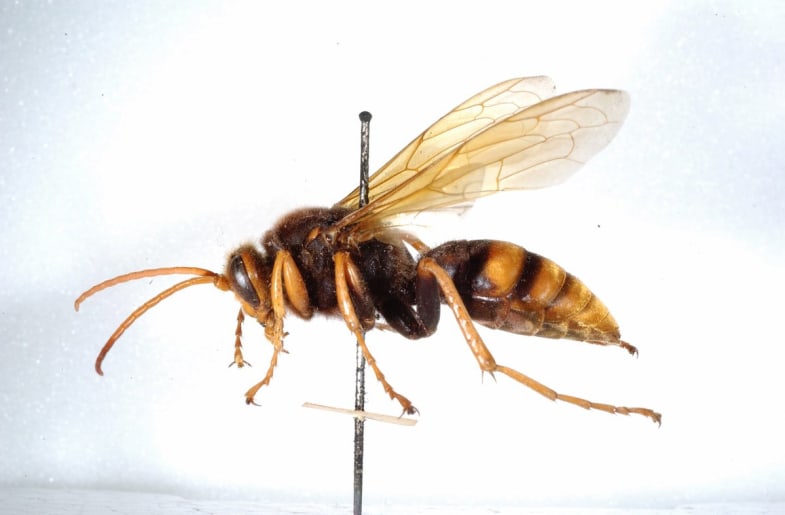The other day the train was late so I sat down to get a twig out of my shoe and got talking to my neighbour on the bench. She discovered I was a bug person (‘bug-a lugs’ when I was a student) and told me she had hornets in the back garden. That surprised me, as Australia (fortunately) doesn’t have true hornets.
The real hornet is a northern hemisphere thing of the genus Vespa. It’s basically a giant ‘European wasp’ (= Vespula germanica) and like the European wasp is nastily aggressive, social and makes papery nests. Some get pretty large, eg the Giant Asian Hornet (Vespa mandarinia) is up to 5cm (2 inches in old money) long.
Hornets occur as far south as Bali, where they are mostly black with thin yellow bands and rather pretty – but best avoided. They seem to prefer rainforests to beaches. Hornets and wasps can kill, like honeybees, by severe allergic reaction. But they also release a neurotoxin, which in the case of multiple stings can also kill and, unlike honeybees, each individual can sting multiple times. This is why their aggression makes them dangerous.
It’s probably fair to say (to the wasp) that anything that stings can kill by allergic reaction. Fortunately our stingy wasps are not so aggressive.
So what was the wasp in the back garden in the Illawarra? Fortunately my neighbour on the bench had photographed it. It was a giant potter wasp, Abispa ephippium, which is a solitary wasp (ie not forming large colonies) of a mere 3cm length, which makes a mud chamber in a loose rock wall or similar. The chamber is packed with paralysed caterpillars which the larva feeds on. These wasps are not aggressive and although they sting, the sting is mild (the sting of the giant hornet is described as ‘having a hot nail hammered into you’ in Wikipedia).
Some websites call Abispa the ‘Australian Hornet’ but I think it’s less confusing to not use hornet for any of our native wasps. Once we get them, yes, they are spreading in the world, I think you’ll appreciate the difference!
There are actually larger native wasps than Abispa in this area, for example the Cicada Killer Wasp, Exeirus, which is 4cm long and also solitary. These paralyse cicadas, collected in tree tops, and drag them into underground burrows for their larvae. They have a bad sting, but are rarely encountered – it would be exciting to see one.
All of these wasps, Vespa, Vespula, Abispa and Exeirus, have the same ‘waspy’ appearance – narrow waist, folding wings, and yellow and brown or black banding. Their colours are warning you to avoid them. This is a collective mimicry system, called Mullerian mimicry. And, of course, being the natural world, many insects cheat and pretend to be nasty wasps, but aren’t. This is Batesian mimicry. More on them in another post.









